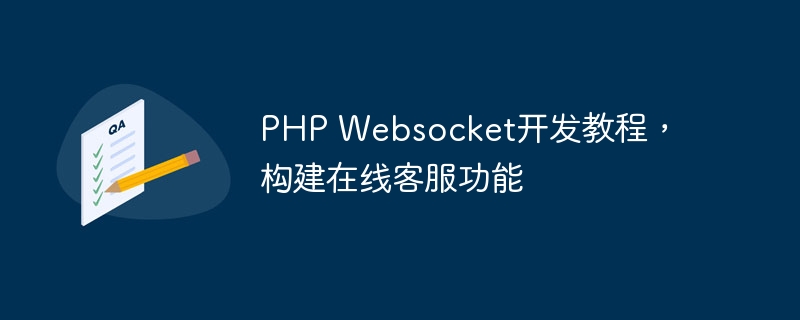

PHP Websocket development tutorial, building online customer service function, requires specific code examples
Introduction:
With the rapid development of the Internet, more and more enterprises Start integrating online customer service functionality into your website. Traditional customer service systems based on HTTP protocol often have problems such as message delay and low real-time performance. The use of Websocket technology can achieve real-time two-way communication, which can better meet users' immediate customer service needs. This article will introduce how to use PHP to develop Websocket and provide specific code examples to help readers build online customer service functions.
1. What is Websocket?
Websocket is a network protocol for full-duplex communication over a single TCP connection. It can establish a persistent connection between the client and the server to achieve real-time communication. Compared with the traditional HTTP protocol, Websocket has the characteristics of low latency and high performance, and is suitable for real-time application scenarios, such as chat rooms, online games, and online customer service.
2. The process of developing Websocket in PHP:
1. Create a WebSocket Server: Use a PHP class library or framework to create a WebSocket Server object.
2. Handle WebSocket connection requests: listen to client connection requests and authenticate as needed.
3. Process client messages: After the WebSocket connection is established, the client can send text, binary or Ping messages to the server, and the server needs to parse and process these messages.
4. Send messages to the client: The server can actively send messages to the client, and the client needs to respond and process these messages.
5. Close the WebSocket connection: When the communication ends, the server or client can close the WebSocket connection.
3. Use Ratchet library to develop Websocket:
Ratchet is a popular class library for developing Websocket applications in PHP. It provides a simple and easy-to-use API and event-driven mechanism to facilitate developers to quickly build Websocket. application.
The following is a sample code for a Websocket server based on Ratchet:
use RatchetMessageComponentInterface;
use RatchetConnectionInterface;
class ChatServer implements MessageComponentInterface {
protected $clients;
public function __construct() {
$this->clients = new SplObjectStorage;
}
public function onOpen(ConnectionInterface $conn) {
$this->clients->attach($conn);
echo "New connection! ({$conn->resourceId})
";
}
public function onMessage(ConnectionInterface $from, $msg) {
foreach ($this->clients as $client) {
if ($from !== $client) {
$client->send($msg);
}
}
}
public function onClose(ConnectionInterface $conn) {
$this->clients->detach($conn);
echo "Connection {$conn->resourceId} has disconnected
";
}
public function onError(ConnectionInterface $conn, Exception $e) {
echo "An error has occurred: {$e->getMessage()}
";
$conn->close();
}
}
// 创建WebSocket服务器
$server = RatchetServerIoServer::factory(
new RatchetHttpHttpServer(
new RatchetWebSocketWsServer(
new ChatServer()
)
),
8080
);
$server->run();In the above code, we created a ChatServer class that implements the MessageComponentInterface interface, which defines The event handling method that the WebSocket server needs to implement. In the onOpen method, we store the client connection through the SplObjectStorage object. In the onMessage method we loop through all client connections and send the message to other clients besides the sender. In the onClose method, we remove the connection from SplObjectStorage when the client closes the connection.
4. Build online customer service function
Through the above code example, we can already build a simple Websocket server. Next, we can further develop the online customer service function according to our own needs. For example, we can assign a unique ID to each client to establish one-to-one communication between customer service staff and customers.
For customer service staff, we can develop a backend management system to receive and process messages from customers and send replies to customers. For customers, we can add an online customer service button on the homepage of the website. After clicking the button, a small window can be opened for real-time communication with customer service personnel.
We can send a welcome message in the onOpen method and assign a unique ID to the client. When a customer message arrives, we can process it according to the message content in the onMessage method and send the reply to the corresponding client.
5. Summary
This article introduces how to use PHP to develop Websocket, and provides specific code examples to help readers build online customer service functions. Through Websocket technology, we can achieve real-time two-way communication and improve the user experience of the website. Readers can further optimize and extend this simple example to build more complex and practical Websocket applications according to their own needs.
The above is the detailed content of PHP Websocket development tutorial, building online customer service function. For more information, please follow other related articles on the PHP Chinese website!